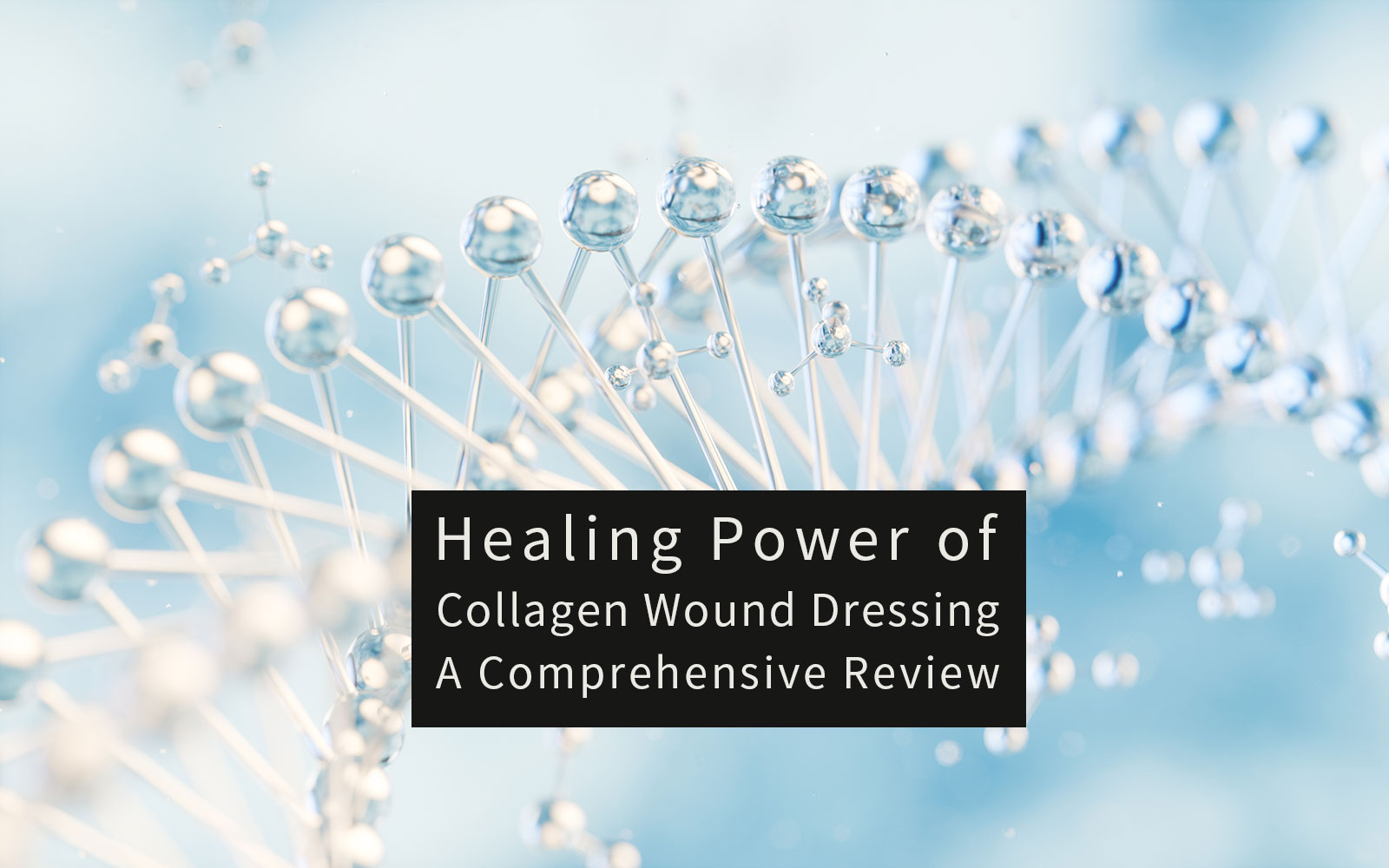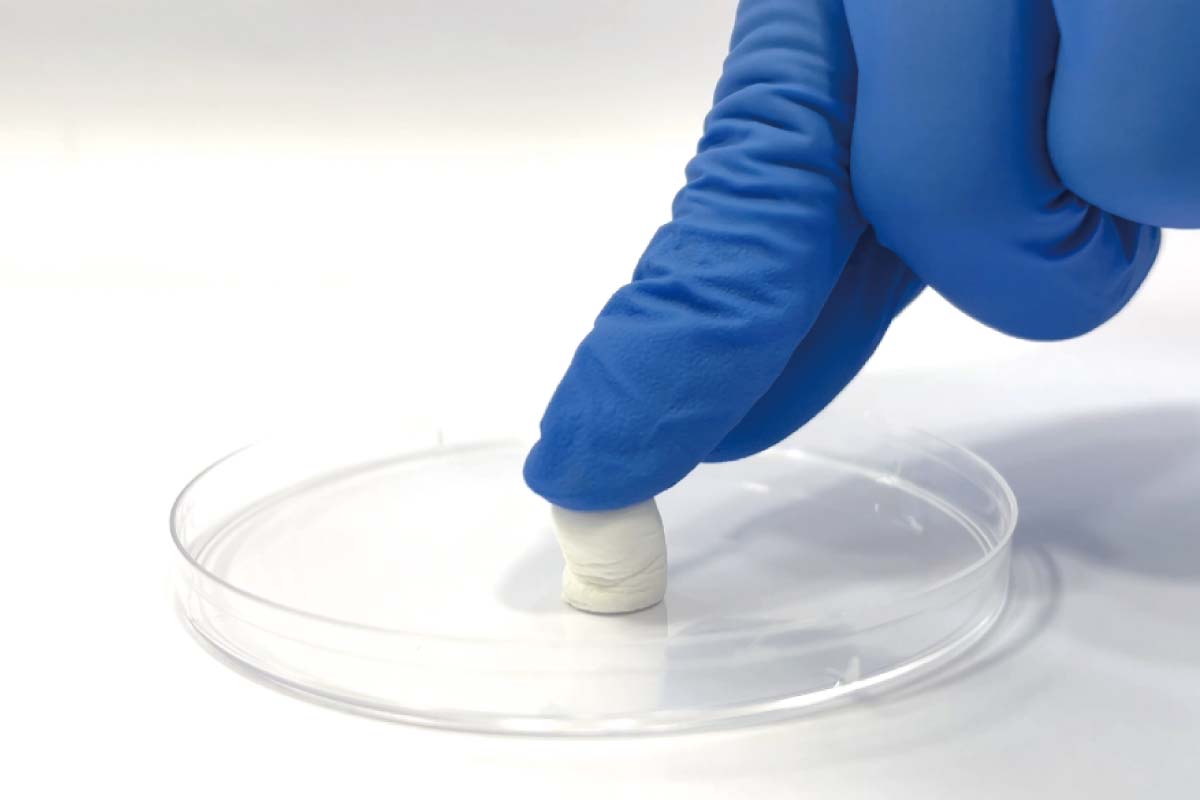Table of Contents
¿Qué es un vendaje de colágeno? ¿Cómo funciona el vendaje de colágeno?
Los apósitos de colágeno son láminas, esponjas, tapones, películas, geles y partículas, que están compuestos por distintos tipos de colágeno, generalmente derivados de bovinos, porcinos o equinos. El colágeno es la proteína más abundante en el cuerpo de los vertebrados y es un sustrato esencial para la adhesión y migración celular. Además, el colágeno es un activador importante para la adhesión y agregación de plaquetas después de una lesión. El vendaje de colágeno es efectivo en la hemostasia, la cicatrización de heridas y la regeneración.
¿Qué tipos de apósitos de colágeno son los mejores para la cicatrización de heridas?
Existen un total de 28 tipos diferentes de colágeno que se dividen en ocho subfamilias, siendo la mayoría de los tipos de colágeno parte de la subfamilia formadora de fibrillas o fibrilar (ref 1). Esta subfamilia incluye el colágeno tipo I y III, que son los componentes más abundantes de la matriz extracelular de la capa dérmica de la piel. Además, los tipos de colágeno I, II y III son los colágenos fibrilares más prevalentes. La característica única del colágeno es la presencia de una triple hélice que puede variar desde el 96% (en el colágeno tipo I) hasta menos del 10% (en el colágeno tipo XII). Por lo tanto, el colágeno tipo I será la mejor opción para usar en la cicatrización de heridas con apósitos de colágeno.
Ref. 1: Sources of Collagen for Biomaterials in Skin Wound Healing. Bioengineering 2019, 6, 56.
Colágeno Tipo I:
El colágeno tipo I forma una estructura con fibras gruesas que sirven como soporte estructural en músculos, piel, tendones, vasos sanguíneos, pulmones y corazón, y también constituye el material orgánico en tejidos calcificados como huesos y dientes. Tanto el colágeno tipo I como el tipo III son necesarios para la cicatrización de heridas y la regeneración de tejidos. El colágeno tipo III juega un papel importante durante las primeras fases, mientras que el colágeno tipo I se sintetiza en gran cantidad durante las etapas finales.
Colágeno Tipo II:
El colágeno tipo II también es un colágeno fibrilar y es el componente principal del cartílago, siendo importante para proporcionar resistencia a la tensión en el tejido. El colágeno tipo II se ha utilizado como biomaterial en la aplicación de regeneración ósea o del cartílago; sin embargo, es menos conocido por su efecto en la cicatrización de heridas en la piel.
Colágeno Tipo III:
El colágeno tipo III es uno de los factores dominantes en la maduración del colágeno tipo I, produciendo fibras delgadas y menos duraderas con un recambio rápido, aunque es menos estable en comparación con el colágeno tipo I. En los mamíferos, las fibras reticulares hechas de colágeno tipo III se observan comúnmente junto con el colágeno tipo I.
Formatos de apósitos de colágeno
La preparación del colágeno para su uso como biomaterial se puede dividir en dos enfoques: el colágeno insoluble y el colágeno soluble. El enfoque principal en las aplicaciones de apósitos de colágeno es el colágeno insoluble, que mantiene la estructura biológica y los enlaces intermoleculares del colágeno inherente en el cuerpo humano.
Los apósitos de colágeno se pueden formar en andamios tridimensionales con formas como láminas, esponjas, tapones, películas, geles, partículas, etc.
En general, los formatos de apósitos de colágeno, como la lámina de colágeno, la esponja, la película y las partículas, se pueden aplicar en diversas heridas epidérmicas o dérmicas, como quemaduras, heridas traumáticas, heridas quirúrgicas, heridas crónicas, etc.
1/ Apósito de colágeno en lámina
El apósito de colágeno se prepara normalmente mediante procesos de moldeo y liofilización, y luego se pueden realizar diferentes formas o dimensiones utilizando un molde de colado específico. El apósito de colágeno en lámina se puede utilizar como cobertura temporal o permanente para heridas superficiales relacionadas con lesiones epidérmicas o dérmicas. Durante la cicatrización de heridas, la capacidad de crecimiento celular dentro de un apósito de colágeno depende del tamaño de los poros y la porosidad de su estructura fibrosa. El apósito de colágeno en lámina es muy adecuado para quemaduras, úlceras y heridas quirúrgicas, ya que revela una rápida epitelización y un crecimiento denso de tejido fibroso en las capas subdérmicas.
2/ Apósito de colágeno en partículas
El apósito de colágeno en partículas se puede espolvorear suficientemente para cubrir la superficie de la herida en situaciones irregulares, como las heridas tunelizadas. Lo más importante es que el apósito de colágeno en partículas se puede mezclar con solución salina normal para hacer una pasta o una solución que se aplique más fácilmente sobre la herida.
3/ Apósito de colágeno en forma de tapón
Además del manejo de heridas superficiales, el apósito de colágeno también se utiliza ampliamente en odontología. Recientemente, la preservación del alveolo es una estrategia efectiva para mantener el volumen óseo después de la extracción dental. El apósito de colágeno en tapón es una matriz de colágeno con forma cilíndrica que se ajusta en el alveolo de extracción, proporcionando un andamio para el crecimiento de células periosteales, lo cual es adecuado para aplicaciones en ingeniería de tejidos óseos.
4/ Apósito de colágeno en gel
Los materiales en forma de gel han ganado importancia en el manejo de heridas debido a su alto contenido de agua y excelente adhesión a los tejidos. Además, los materiales en forma de gel son más fáciles de incorporar componentes activos, como agentes antibacterianos, en comparación con los apósitos en forma de lámina o esponja. Según investigaciones recientes, los apósitos de colágeno en gel se componen de colágeno puro, mezclas de colágeno con polímeros naturales y/o sintéticos, o mezclas de colágeno con bioactivos, y son necesarios para un mejor manejo de las heridas cutáneas debido a la diversidad de tipos de heridas y la complejidad ambiental.
Los 5 principales beneficios de usar apósitos de colágeno para heridas crónicas
- El colágeno es la proteína más abundante en el cuerpo de los vertebrados;
- El colágeno es quimiotáctico para los elementos celulares de la cicatrización, como los granulocitos y los fibroblastos;
- El apósito de colágeno puede formarse como un andamio tridimensional con diferentes especificaciones para distintos tipos de heridas;
- El apósito de colágeno es una matriz porosa que favorece la adhesión, migración y proliferación celular;
- El apósito de colágeno sirve como un sustrato ideal para promover la maduración de la herida al alinearse con el lecho de la herida nativa, es decir, para mejorar la calidad de la cicatrización.
¿Cuánto tiempo tarda el apósito de colágeno en promover la cicatrización?
La cicatrización de heridas se puede dividir en una secuencia de cuatro fases dependientes del tiempo, que incluyen:
- Coagulación y hemostasia, inmediatamente después de la lesión;
- Inflamación, que comienza poco después;
- Proliferación, que comienza dentro de los días posteriores a la lesión;
- Remodelación de la herida, en la que se forma el tejido cicatricial y que puede durar hasta un año o más.
El apósito de colágeno sirve como un sustrato ideal para promover la maduración de la herida al alinearse con el lecho de la herida nativa. Es decir, el apósito de colágeno será efectivo para acortar el tiempo en la fase de remodelación de la herida y, por lo tanto, mejorar la calidad de la cicatrización.
¿Se puede usar el apósito de colágeno en heridas infectadas?
En las heridas infectadas, la respuesta inflamatoria sigue en un nivel relativamente alto y las células inflamatorias secretan diversos tipos de enzimas, como las metaloproteasas de matriz (MMP), que pueden degradar el colágeno in situ. Por lo tanto, no se recomienda el uso de apósitos de colágeno en heridas infectadas.
¿Con qué frecuencia debo cambiar el apósito de colágeno?
El ciclo de tratamiento dependerá del progreso de la cicatrización de la herida. El colágeno es un material biodegradable, por lo que no es necesario retirar el apósito de colágeno después de usarlo. En lugar de eso, a medida que el apósito de colágeno original se degrade, se puede colocar uno nuevo en la herida cuando sea necesario.
¿Qué factores se deben considerar al determinar la frecuencia de cambio del apósito de colágeno?
El apósito de colágeno tiene la capacidad de mantener el proceso de cicatrización al mantener un ambiente húmedo alrededor de la herida, así como al absorber el exudado. Por lo tanto, se debe usar un nuevo apósito si todavía hay mucho exudado de la herida o si el apósito de colágeno ha sido absorbido.
Mejor rendimiento de absorción: apósito de colágeno en hidrogel y apósito de colágeno con alginato
El material de alginato es uno de los apósitos avanzados para heridas que tiene propiedades antibacterianas significativas y puede absorber muchas veces su propio peso en exudado. Además, el material de alginato también tiene propiedades hemostáticas, pero se recomienda para el control de hemorragias menores (por ejemplo, en heridas post-desbridamiento). Es decir, el material de alginato no será adecuado para el tratamiento de hemorragias más graves.
Por el contrario, el apósito de colágeno no solo es un importante activador para la adhesión plaquetaria después de hemorragias más graves, sino que también sirve como un sustrato ideal para promover la maduración de la herida al alinearse con el lecho de la herida nativa. Por lo tanto, el apósito de colágeno combinado con material de alginato puede ofrecer el soporte estructural del colágeno y las propiedades formadoras de gel del alginato, siendo así más efectivo en el manejo de heridas.
¿Qué es el apósito de colágeno bovino?
Los apósitos de colágeno están compuestos por colágeno obtenido de diversas fuentes, como bovinos, porcinos, marinos, equinos, siendo los bovinos y porcinos los más comunes. Existe una gran demanda de apósitos de colágeno de origen bovino en lugar de porcino debido a ciertas creencias religiosas. El colágeno bovino presenta baja inmunogenicidad y características positivas con una respuesta inmune limitada.
¿Se puede usar el apósito de colágeno bovino en pacientes con alergias a productos de origen animal?
El colágeno derivado de tejido animal es biocompatible y seguro para uso clínico después de eliminar el telopéptido, que es un riesgo potencial para la respuesta inmune. Sin embargo, no se recomienda utilizar apósitos de colágeno hechos de fuentes animales en pacientes con un historial de alergias graves o hipersensibilidad a productos derivados de animales, como bovinos o porcinos.
¿Existen efectos secundarios o riesgos asociados con el uso de apósitos de colágeno?
Los productos biomédicos a base de colágeno se presentan en forma de andamios, hemostáticos, injertos de piel y apósitos para heridas. La biocompatibilidad, el bajo riesgo de infección y la baja inmunogenicidad respaldan firmemente el uso de apósitos de colágeno en el manejo de heridas.
¿Cómo elegir el mejor apósito de colágeno para heridas?
Se espera que el mejor apósito de colágeno para heridas cumpla con los siguientes requisitos:
- No alergénico, no sensibilizante
El apósito de colágeno se prepara principalmente a partir de fuentes animales, por lo que la verificación científica, como la eliminación del telopéptido y la inactivación de virus durante el desarrollo del apósito de colágeno, será crítica para garantizar la seguridad en su uso clínico. - Altamente hemostático y microambiente húmedo
Una de las características más importantes del apósito de colágeno es su excelente propiedad hemostática, que se debe a la adhesión plaquetaria y la absorción de exudado después de hemorragias más graves. Por lo tanto, la porosidad del apósito de colágeno será un índice crítico para la propiedad hemostática. En general, una porosidad superior al 80% y una capacidad de absorción de exudado mayor que 20 veces su propio peso serán más adecuadas para su uso clínico.
¿Cuáles son las contraindicaciones para el uso de apósitos de colágeno?
Casi no hay contraindicaciones para el uso de apósitos de colágeno. Por favor, no utilice el apósito de colágeno en heridas infectadas ni en pacientes con historial de alergias graves o hipersensibilidad a productos derivados de animales.
¿Cómo se compara el apósito de colágeno con otros productos para el cuidado de heridas en términos de rentabilidad y resultados para el paciente?
Existen muchos ensayos clínicos que se utilizan para verificar la eficacia de los apósitos de colágeno, desempeñando un papel notable en el tratamiento de heridas como quemaduras de primer, segundo y tercer grado, úlceras diabéticas en el pie, úlceras por presión, heridas quirúrgicas, etc. (ref 2). En un estudio comparativo entre el tratamiento con láminas de colágeno y apósitos de heparina para quemaduras de segundo grado, se concluyó que el grupo tratado con colágeno mostró mejores resultados que el grupo tratado con heparina en términos de tolerancia al apósito y relación costo-beneficio. Otro estudio comparativo entre apósitos de colágeno y gasas de parafina en 20 pacientes adultos que requerían 40 cm² de piel, realizado por Sreekumar et al., reveló que el grupo tratado con apósitos de colágeno experimentó menos dolor y se observó una mayor epitelización del colágeno en el día 10 en comparación con la gasa de parafina.
Ref. 2: Bovine Based Collagen Dressings in Wound Care Management. Journal of Pharmaceutical Research International 2020;32(33):48-63.







